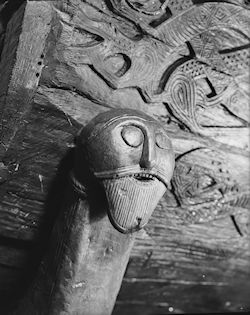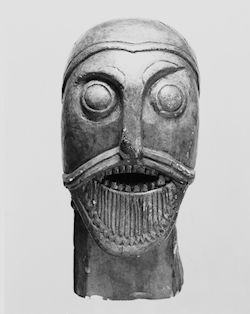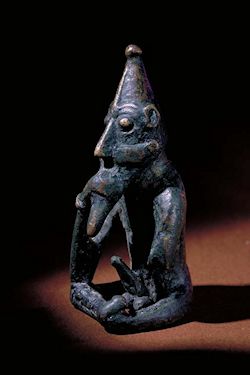Department of Archaeology, University of York, YO1 7EP, UK.
Email: steve.ashby@york.ac.uk
Cite this as: Ashby, S.P. 2016 Grooming the Face in the Early Middle Ages, Internet Archaeology 42. http://dx.doi.org/10.11141/ia.42.6.9
In the contemporary world, the significance and associations of facial hair are plain to see, but nonetheless complex for that. Though the years after c.2010 have seen an unexpected return of the beard to western fashion, by early in 2015 something of a backlash against such 'hipsters' had begun. In the context of radical Islam too, Orientalist perceptions of beards should not be overlooked (Awan and Zempi 2015; Culcasi and Gokmen 2011); facial hair is an easy touchstone for the 'Othering' of ethnic groups (see Pohl 1998; Said 1978).
Moreover, traditional attitudes regarding whether men in positions of power should sport beards have continued to hold traction in the west; the USA has not had a president with facial hair since W.H. Taft (1857-1930), while the last US Head of State to sport a full beard was Benjamin Harrison (1833-1901). In the UK, the response to the reporter Jeremy Paxman growing one was forthright (Marsden 2013). So deep-seated is the western world's association between trustworthiness, professionalism, and a clean-shaven chin that it is easy to think that this is natural, a human universal. But one need only look back to the 19th century to see that it has not always been so, even in Europe and North America, where the advent of the safety razor provides an excellent case study in the inextricability of technological and social change (Herzig 2015, 119-27).
With this in mind, the history of the beard and its social and political associations seems a fruitful field of study. Though certainly not overrun with scholarship, I am not alone in this pursuit (see Beauman 2015); indeed, in 2011 Australia's National Portrait Gallery ran a 'Mo Show', while late 2015 saw an interdisciplinary conference entitled 'Framing the Face' (Withey and Evans 2015). Nonetheless, none of these studies concern themselves with my topic here: beards in the early medieval, proto-historic period.
There is of course no reason to doubt that the cultivation and styling of facial hair has considerable antiquity (for accessible reviews see Hawksley 2014; Peterkin 2001). Notwithstanding the existence of razors and similar bladed tools in prehistory, except in rare cases such as a few Iron-Age bog bodies (e.g. Roum Man, Kreepen-Brammer Man; Neu Versen Man; see Gill-Robinson 2005), beards are all but impossible to perceive in the archaeological record. Past societies represented today by art, complex technology, writing, and bodily preservation (natural or artificial mummification) foster a greater level of confidence to explore the social contexts of hair behaviour. Egypt, in particular, has a plethora of sources with which to work. Though it seems that body hair was commonly removed, the beard was seen as set apart from this, and came to represent status, to such an extent that postiches — strap-on beards — were commonly used by royalty in Old Kingdom Egypt. Art of the Near East (e.g. Iran, Assyria, shows a fashion for rather exaggerated, luxuriant beards), while the idea that in ancient Greece, beards stood for both virility and wisdom has become widely accepted.
In Rome, beards appear to have waned in popularity among people of standing between the late Republican period and the 2nd century AD, presumably in line with cultus, the indulgent attention to personal grooming so bemoaned by Roman commentators such as Seneca (see Toner 2015 for a discussion of how far this elite literary commentary reflected everyday practice). The fashion appears to have briefly reverted to the hirsute under the rule of Hadrian and his successors Marcus Aurelius and Septimius Severus. Though Hadrian's decision was explained away in the Historia Augusta (HA Spart. Hadr. 26) as an attempt to conceal facial blemishes, this does little to explain the style's widespread and persistent popularity, and it is probably better seen as part of a package of cultural reinventions introduced by the new emperor (Zanker 1995). The indirect but widespread influence of the powerful is thus visible even in everyday grooming practices, and is certainly related to the ways in which hair and its apparent associations with uncleanliness were used to separate the Roman from the 'barbarian' Other.
Such 'non-Romans' provide an interesting case study; we might in particular consider the Lombards, whose very appellation is traditionally believed to derive from an origin myth in which the group's women disguise themselves as men by tying their hair down to form 'long beards' (Borri 2014). In many ways the historicity of this story matters much less than its existence, while in 'Romans growing beards', Borri (2014) argues that the apparent rise to dominance of Lombardic culture in 7th-century Italy is best viewed not as popular displacement, but rather as a transformation of behaviour, and a transformation in which grooming practices are certainly implicated.
I have argued elsewhere for the significance of head hair to the Merovingian dynasty (Ashby 2014), and while the role played by facial hair in this context is less clear, it does come somewhat into focus in the reign of Charlemagne. In a strategy that was in some ways similar to that employed by Hadrian (see above), he styled himself with a long moustache, perhaps in imitation of images of Theoderic, but certainly as a statement of distinction from the ousted Merovingian dynasty (Dutton 2004).
In England, Alcuin's rebuke of the Anglo-Saxon tendency to emulate Scandinavian hairstyles is well known, but he actually refers directly to facial hair: 'trimming their hair and beard like the pagans', in his mind, to the eventual ruin of England. 'See how you have wanted to copy the pagan way of cutting hair and beards. Are not these the people whose terror threatens us, yet you want to copy their hair?' Of course there is no way of knowing whether Alcuin — who was resident at the court of Charlemagne by this point — ever really saw a Scandinavian beard, or else an Anglo-Saxon attempting to mimic it. It is just as likely that he was using personal appearance as a trope, a sort of visual shorthand for 'pagan ways'. This is potentially even more interesting: why would a scholar fix upon these particular symbols for paganism?
In Ireland, attitudes to hair and beards have been well researched by William Sayers (Sayers 1991), and it suffices to provide an example. A poem known as the Geisi Ulcai (Prohibitions of the beard) preserved in the 14th-century Book of Lecan, but thought to relate a first-millennial tradition (O'Looney 1870, 173, 190-93), outlines clear proscriptions on who can wear a beard, and how. The author claims to be 'a man of great knowledge of what is lawful for every kind of beard'. He notes that:
There are warriors who are entitled to a beard Who are not cowardly — Noble chiefs by land and sea And battle champions.
Conversely:
Artificers, smiths, house-builders. Physicians who cure the infirm. Because of their fatigue they shave every month [The beard] on their faces.
The associations here between status, virility, and the right to grow a beard are both unambiguous and significant (see Sayers 1991 for a fuller discussion and general context). Further north, Viking-Age attitudes to facial hair are not easy to grasp with any certainty. The sagas, recorded several centuries after the end of the Viking Age, contain numerous references to facial hair, often with implications for social standing and status. The most famous example comes from the Saga of Burnt Njál (Cook 2001), in which the apparently noteworthy beardlessness of the eponymous hero is remarked upon immediately upon his introduction, while the term 'dungbeardlings' is repeatedly used for his sons (in an obviously derogatory manner; see Sayers 1994; Phelpstead 2013, 9-10).
In isolation, the above scattered references of variable historicity tell us little; together they at least provide sufficient circumstantial evidence for us to consider the likelihood that facial hair was a recognised and tended-to phenomenon in (early and later) medieval society. But we must turn to archaeology to begin to interpret these references.
Throughout early medieval northern Europe, the prevalence of combs does much to suggest that personal appearance was an important social consideration (e.g. Ambrosiani 1981; Ashby 2011; 2014; Williams 2003). How exactly this was manifest in terms of the grooming of facial hair is unclear. There have been suggestions that miniature combs often found in 'Germanic' graves (see Williams this issue) may have been beard combs, but this is difficult to substantiate.

More telling is the appearance of facial hair in art. In Germanic metalwork, for instance, human masks are a common element, and they are frequently and meaningfully adorned with ornate moustaches (e.g. Martin 2015); see also the Sutton Hoo helmet, in which the moustache and eyebrows famously combine with the nasal to form a bird in flight (Marzinzik 2007). In the more naturalistic sculptural art of Pictish Scotland, there are a number of significant representations of facial hair. The most notable adorns the stone from the Brough of Birsay — a possible Pictish power centre (though see Brundle 2005) — and illustrates a procession of soldiers. The figure at the head of the cortege is often interpreted as the leader; though all the figures are armed and finely dressed, the details of his costume, hair, and face are distinctive. Most notably, he sports a distinctive curled or spiked hairstyle, and a long, pointed beard (Figure 1).


Further artistic evidence shows that at least some 'vikings' wore beards. With its neatly cropped facial hair, the rather naturalistic antler sculpture from Sigtuna is well known, as are the carved heads from the Oseberg ship burial (Figure 2). More abstract examples include the mask in the interlace design on the reverse of the Mammen axe, and, most impressively of all, the exaggerated beards that adorn a distinctive range of figurines known from across Scandinavia, and as far afield as Chernigov, Ukraine (see Perkins 2001, 53-81), the most famous example of which comes from Rällinge, Södermanland (Figure 3). These figurines may well have had an amuletic character, invoking some particular significance or power in the beard, and should clearly not be seen as direct representations of popular styles of grooming. Indeed, it is impossible to say quite how widespread the practice of beard growth was, but the figurines at least demonstrate that the reference was a widely understood one, and there is no reason to consider beards rare, particularly in light of the above-mentioned documentary references.

Recent zoological research suggests that among primates (Grueter et al. 2015), male secondary sexual traits, including hair capes (areas of conspicuously long hair that may cover the head, shoulders and backs of certain primates) and beards, tend to be most well developed and visible in species that live in large, hierarchically ordered groups. The authors suggest that this may relate to the need to clearly display identity, status, dominance, or sexual desirability: a task that is rendered more difficult in large, anonymous societies characterised by significant conflict. While of course I am not advocating for either the direct application of analogy from primatological research, or for the interpretation of human behaviour in biologically determinist terms, it is worth considering if there might be a deep-rooted relationship between social complexity, the need to engage with foreigners and aliens, and personal display. Such an assertion would be uncontroversial were we talking about jewellery or personal dress; I simply argue that the same arguments apply to personal appearance, including grooming. Facial hair — perhaps even more than head hair (Ashby 2014) — is both visually conspicuous and easily maintained and manipulated. This makes it an ideal medium for the communication of shorthand statements about identity and social status. The use of beards and moustaches in the maintenance of distinction between individuals and identity groups is easily identified in early-medieval documentary and artistic evidence. It is time we took it seriously.
Ambrosiani, K. 1981 Viking Age Combs, Comb Making and Comb Makers in the Light of Finds from Birka and Ribe. Stockholm Studies in Archaeology 2, Stockholm: Almqvist and Wiksell.
Ashby, S.P. 2011 'An atlas of medieval combs from northern Europe', Internet Archaeology 30. http://dx.doi.org/10.11141/ia.30.3
Ashby, S.P. 2014 'Technologies of appearance: hair behaviour in Early-Medieval Britain and Europe', Archaeological Journal 171. 153-186. http://dx.doi.org/10.1080/00665983.2014.11078265
Awan, I. and Zempi, I. 2015 'We fear for our lives. Offline and online experiences of Anti-Muslim hostility', Birmingham City University and Nottingham Trent University. http://tellmamauk.org/wp-content/uploads/resources/We%20Fear%20For%20Our%20Lives.pdf [Last accessed: 26 Nov. 2015]
Beauman, N. 2015 'Of Beards and Men: The Revealing History of Facial Hair by Christopher Oldstone-Moore: review', Guardian, 23 Oct. 2015 http://www.theguardian.com/books/2015/oct/23/beards-men-history-christopher-oldstone-moore-review [Last accessed: 26 Nov. 2015]
Borri, F. 2014 'Romans growing beards: identity and historiography in seventh-century Italy', Viator 45, Turnhout: Brepols. 39-71.
Brundle, A. 2005 'The unimportance of early Birsay' in O. Owen (ed.) The World of Orkneyinga Saga: the Broad-Cloth Viking Trip, Kirkwall: Orkney Museums and Heritage. 88-110.
Cook, R. 2001 Njál's Saga. Harmondsworth: Penguin.
Culcasi, K. and Gokmen, M. 2011 'The face of danger. Beards in the U.S. media's representations of Arabs, Muslims, and Middle Easterners', Aether: Journal of Media Geography 8. 82-96. http://mgm.arizona.edu/sites/default/files/articles-pdf/culcasi.pdf
Dutton, P.E. 2004 'Charlemagne's mustache' in P.E. Dutton (ed.) Charlemagne's Mustache and Other Cultural Clusters of a Dark Age, New York: Palgrave MacMillan, 3-42. http://dx.doi.org/10.1007/978-1-137-06228-4_1
Gill-Robinson, H.C. 2005 The Iron Age Bog Bodies of the Archaeologisches Landesmuseum, Schloss Gottorf, Schleswig, Germany, Schleswig: Schloss Gottorf. http://mspace.lib.umanitoba.ca/handle/1993/20204
Grueter, C.C., Isler, K. and Dixson, B.J. 2015 'Are badges of status adaptive in large complex primate groups?', Evolution and Human Behavior: Official Journal of the Human Behavior and Evolution Society 36. 398-406. http://dx.doi.org/10.1016/j.evolhumbehav.2015.03.003
Hawksley, L. 2014 Moustaches, Whiskers and Beards, London: National Portrait Gallery.
Herzig, R.M. 2015 Plucked: A History of Hair Removal (Biopolitics), NYU Press. http://www.amazon.co.uk/Plucked-History-Hair-Removal-Biopolitics/dp/1479840823
Marsden, S. 2013 'Bearded Paxman hits out at BBC bias against facial hair', Telegraph 13 Aug. 2013. http://www.telegraph.co.uk/culture/tvandradio/bbc/10240382/Bearded-Paxman-hits-out-at-BBC-bias-against-facial-hair.html [Last accessed: 26 Nov. 2015]
Martin, T.F. 2015 The Cruciform Brooch and Anglo-Saxon England. Anglo-Saxon Studies. Boydell Press. https://books.google.co.uk/books?id=E6GfBwAAQBAJ
Marzinzik, S., 2007 The Sutton Hoo Helmet (Objects in Focus). http://www.amazon.co.uk/The-Sutton-Helmet-Objects-Focus/dp/0714123250
O'Looney, B. 1870 'Tochmarc bec Fola', Proceedings of the Royal Irish Academy, MSS Series 1, Dublin: M.H. Gill. 172-202.
Perkins, R. 2001 Thor the Wind-raiser and the Eyrarland Image, Viking Society for Northern Research Text Series Vol. 15, Viking Society: University College London.
Peterkin, A. 2001 One Thousand Beards: A Cultural History of Facial Hair, Vancouver: Arsenal Pulp Press. Phelpstead, C. 2013 'Hair today, gone tomorrow: hair loss, the tonsure, and masculinity in Medieval Iceland', Scandinavian Studies: Publication of the Society for the Advancement of Scandinavian Study 85, University of Illinois Press. 1-19.
Phelpstead, C. 2013 'Hair Today, Gone Tomorrow: Hair Loss, the Tonsure, and Masculinity in Medieval Iceland', Scandinavian Studies 85.1. 1-19.
Pohl, W. 1998 'Telling the difference: signs of ethnic identity' in W. Pohl and H. Reimitz (eds) Strategies of Distinction: the Construction of Ethnic Communities, 300-800. Leiden: Brill. 17-69.
Said, E.W. 1978 Orientalism, London: Routledge and Kegan Paul.
Sayers, W. 1991 'Early Irish attitudes towards hair and beards, baldness and tonsure', Zeitschrift für celtische Philologie 44. 154-89.
Sayers, W. 1994 'Njáll's beard, Hallgero'r's hair and Gunnarr's Hay: homological patterning in Njáls Saga', Tijdschrift voor Skandinavistiek 15(2). 5-31.
Toner, J. 2015 'Barbers, barbershops and searching for Roman popular culture', Papers of the British School at Rome 83. 91-109. http://dx.doi.org/10.1017/S0068246215000057
Williams, H. 2003 'Material culture as memory: combs and cremation in early medieval Britain', Early Medieval Europe 12. 89-128. http://dx.doi.org/10.1111/j.0963-9462.2004.00123.x
Withey, A. and Evans, J. 2015 'Framing the Face: New perspectives on the history of facial hair. One-day Workshop: 28th November 2015'. https://framingtheface.wordpress.com/ [Last accessed: 26 Nov. 2015].
Zanker, P. 1995 The Mask of Socrates. The Image of the Intellectual in Antiquity, Berkeley: University of California Press.
The comments facility has now been turned off.
Internet Archaeology is an open access journal based in the Department of Archaeology, University of York. Except where otherwise noted, content from this work may be used under the terms of the Creative Commons Attribution 3.0 (CC BY) Unported licence, which permits unrestricted use, distribution, and reproduction in any medium, provided that attribution to the author(s), the title of the work, the Internet Archaeology journal and the relevant URL/DOI are given.
Terms and Conditions | Legal Statements | Privacy Policy | Cookies Policy | Citing Internet Archaeology
Internet Archaeology content is preserved for the long term with the Archaeology Data Service. Help sustain and support open access publication by donating to our Open Access Archaeology Fund.